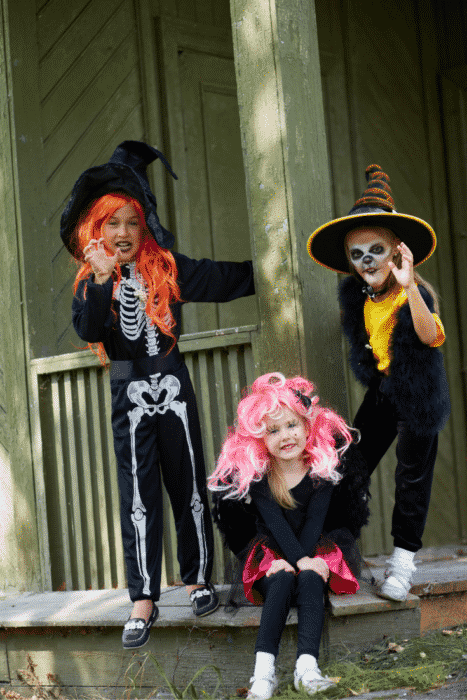The Role of Fear in our Lives
Fear is in our lives to protect us. It is a natural part of our human condition and our bodies are exquisitely built to detect threats and to react to them. (Think flight, fight or freeze.) Fear seeks to keep us alive, and well. It makes us run from threats, be cautious about what we do, play safe, defend and protect our loved ones. Its job is to make sure our genes are passed on. And it does so in remarkable ways.
And yet…
Fear can paralyze us. It can impact our lives in numerous limiting ways. It prevents us from going forward, sleeping well, or enjoying life. It can drive aggression, withdrawal, clinginess, whining, and many of the “off-track” behaviors we see in our children that don't seem to make sense, and drive us crazy.
On top of it all, it's only natural to be afraid of new things. And when we're little, everything is new! We encounter new environments, new tastes, new schools, new siblings, new experiences, new social interactions to navigate, and other new situations on a regular basis.
What our Brains Need
As social creatures we depend on the care of others to survive. Being rejected by our tribe means death. Children instinctively know that they DEPEND on the loving care of adults, as their every need must be met by them. Naturally, then, our brains are designed to develop in sync with, and deeply connected to, our caregivers. It is connection we need, as much as food and sleep, to be alive. Especially when we're little.

We are born powerless, in that sense, and literally need our caregivers to want us, love us, and keep us safe at all times. And that's why connection is as vital to our wellbeing and development as other core needs. When it's there, our brains hum with excitement and endless possibilities for growth.
It makes sense, then, to have a whole portion of our brain, (the limbic system) to help us detect, just like a radar would, the non-verbal signs, the beam of attentiveness, and the loving connection from those who take care of us. If everything is well it tells us: I can thrive now. I can grow. I can relax and be myself.
When that connection is non-existent, or if it's there, but it breaks, as it inevitably does, if even for a minute when mommy answers the phone, a big alarm goes off.
“Am I safe? Am I loved? Do I matter? Am I going to die? ” Our children's brains seem to say. They might panic and involuntarily shut down the thinking portion of their brain (the prefrontal cortex) flooding it with emotion, and fear. Their behavior then, stops making sense. While infants and some young children may burst into tears at this temporary break in connection, some may do what they know is off limits, or become aggressive or withdrawn, as they temporarily lose their emerging self-control or their ability to reason and cooperate.
This is not naughtiness; it’s a big signal for help. And this is, precisely, why the widespread, fear-based intimidation parenting techniques parents worldwide are still expected to use, like threats, punishment or even bribery, are ineffective. They are, at best, missing the mark, and in many cases worsening the situation.
Hand in Hand is Special
The Hand in Hand approach, thankfully, is entirely based on connection. All its tools respond to our core needs to be seen, heard, and loved and work together to foster a profound emotional connection between children and their caregivers. Their secret? These tools rely on a deep understanding of the elegant ways in which our bodies store, process, and release emotions, like fear!
Here's how it works: when given the chance, our intelligent bodies know just how to overcome fear. Laughing, crying, trembling, struggling, and throwing tantrums, among other healthy expressions, do the job of expelling unpalatable feelings. For good, and for real! After big emotional episodes our brains regulate and we can regain our sense of safety in the world. And then we try again. And explore a little more.
When feelings are repressed, however, they stay in our unconscious memories, sometimes stored for decades, and then pop up, unannounced, to interfere with multiple aspects of our lives.
Our role, as parents and caregivers is to support these fundamental mechanisms, and, contrary to what society has told us for years, not to repress, avoid, or condemn them.
Here's how we do it at Hand in Hand:
We play, and elicit laughter by Playlistening, a way of playing that promotes laughter as the adult takes the less powerful role. Or we offer Special Time, a limited chunk of time in which children get to choose what and how to play while we follow along, delighted in their presence.
And when they cry, we listen. We come close, stay, and anchor them with our loving attention. This is what we call Staylistening, and we do it also when they tantrum.
We keep them safe, and stop off-track behavior in a gentle, yet effective way: Moving close and bringing Limits, and ourselves, to our children when they most need us.
And then we seek safe spaces, within the Listening Partnerships that we create with other adults, to off load, in the same effective way, our own emotional tension so that we can approach our daily challenges with more ease.
Kissing Fears Good-bye
After using these tools consistently at home for three years, I've seen my children overcome fears and gain resilience, self-esteem and freedom. I've also grown in confidence and skill, and I'm closer to their hearts than I have ever been.
The Hand in Hand tools have become our way of life and we've used them to tackle different situations, big and small: fear of swimming, of riding bikes without training wheels, bulling, separation anxiety, potty training, weaning, and sibling rivalry, just to name a few.
Here's an example of how we once used Staylistening to regain the sense of safety after a very frightening experience:
 A couple of years ago, when my children were five and three we did what's customary here in the US and went from house to house in our neighborhood on Halloween night to ask for candy. They were having a great time until we reached a house that had truly scary decorations and sound effects. The owner, who was dressed in a monster costume, approached them and offered them candy in a creepy voice. They took it, and as fast as they could, moved on to the next house. I could feel that they were tense after the interaction, so I asked them if they were OK. They said they were, and continued trick or treating.
A couple of years ago, when my children were five and three we did what's customary here in the US and went from house to house in our neighborhood on Halloween night to ask for candy. They were having a great time until we reached a house that had truly scary decorations and sound effects. The owner, who was dressed in a monster costume, approached them and offered them candy in a creepy voice. They took it, and as fast as they could, moved on to the next house. I could feel that they were tense after the interaction, so I asked them if they were OK. They said they were, and continued trick or treating.
As soon as we got home they dumped their candy treasure on the floor and started showing off track behavior, signaling for help. They fought about who had gotten more, snatched some pieces from each other, unwrapped many pieces (even when we had agreed on eating just a couple that night) and stuffed them in their mouths. Then they ran upstairs and were literally “bouncing of the walls”, jumping on their beds and completely out of control. I had a sense of what might be happening, and very calmly approached them and said, “Hey, my loves, come here” and as I held their hands, and looked at them in the eye I asked them “Was that house scary?”
They looked at me, nodded, and immediately burst out crying. They screamed and screamed, making lots of movement and noise. I remained calm and staylistened as they both expelled this frightening experience. After a few minutes of this agitated expression they seemed much more relaxed, but kept on crying. They told me what had been so hard about it, and came to their own resolution never to go to that house again on a Halloween night.
They finished crying, and it was palpable that they had regained their sense of safety and wellbeing. They were back to being themselves! They went to sleep peacefully, and, not surprisingly, woke up the next morning much more relaxed about sharing and savoring their delicious treats.
If you wish to join the growing number of parents worldwide who are experimenting with these tools, and kissing paralyzing fears good-bye, check out these resources from Hand in Hand. I'm sure you'll be amazed by the results, and so glad you did!
From the Hand in Hand Toolbox:
Learn how children heal fear through play and how you can set limits without fear of shame.
Get our free e-guide to Setting Healthy Limits
Our book is out now! Listen: Five Simple Tools to Solve Your Everyday Parenting Challenges gives parents simple strategies with 100s of real-life examples. Buy the book here.
Marilupe de la Calle is a Mexican mom living in the US with her husband and two amazing girls. You can connect with Marilupe on Facebook at Parenting by Connection with Marilupe
